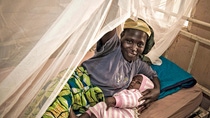Agriculture
No flight, no bite – Interceptor® G2 net nearly halves malaria infection in Tanzanian children
In our efforts to combat the spread of malaria, our researchers have created the Interceptor® G2 bed net that makes mosquitoes unable to fly or move and thereby reduces infection rates among children by up 60%., according to new research published in The Lancet.
The study was conducted by the London School of Hygiene & Tropical Medicine (LSHTM), National Institute for Medical Research, Kilimanjaro Christian Medical University College in Tanzania, and the University of Ottawa, Canada. It was a two-year community trial that followed over 4500 children aged 6 months to 14 years in Tanzania. A further study is underway in Benin, which will help establish Interceptor® G2’s effectiveness in different settings. The World Health Organization will make a recommendation for use based on the Tanzania and Benin studies.
What's the best way to stop mosquitoes from spreading malaria?
It turns out that Interceptor® G2, treated with a combination of two active ingredients, alpha-cypermethrin and chlorfenapyr, reduced prevalence by 43% in year one and 37% in the first and second year respectively, compared to the standard pyrethroid only long-lasting insecticidal net (LLIN). It also reduced clinical episodes of malaria by 44% over the two years and the number of malaria-infected mosquitoes captured by 85%.
Unlike other insecticides which kill the mosquito via the nervous system, the effects of Interceptor® G2 mean the mosquito dies from starvation or being unable to fend for itself.
This is how our bed nets are the cornerstones of malaria control in sub-Saharan Africa. However, in the past few years the decline in malaria has stalled and even reversed in some countries. In 2020, there were 627,000 deaths from malaria, mainly in Africa and occurring mostly in children.
.jpg)
Malaria’s resurgence is partly due to the bed nets’ effectiveness being compromised by widespread resistance to pyrethroid insecticides in Anopheles mosquitoes. The game changing Chlorfenapyr, a new active ingredient in the field of Public Health, works very differently to pyrethroid, causing wing muscle cramps that stop the flight muscles from functioning. This prevents mosquitoes from making further host contacts or biting, ultimately leading to their death.
According to the Lancet study, Interceptor® G2 could lead to significant malaria control gains in sub-Saharan Africa. And yet, more research is needed to examine feasibility of scale-up, and on resistance management strategies needed to preserve their effectiveness long term.
Dr Jacklin F. Mosha from the National Institute for Medical Research, Tanzania, the study’s first author, said in the press release: “Malaria remains a huge problem across sub-Saharan Africa and is one of the leading causes of death in Tanzania. We urgently need new interventions to get control efforts back on track and protect young people from this deadly disease.
These exciting results highlight that we have another effective tool to help control malaria.
Children from 72 villages in Misungwi, where high levels of resistance to pyrethroids have been reported, were randomised into groups and received one of three of the most promising new generation of bed nets. Children were then tested for malaria at the end of each rainy season.
After 24 months, malaria infection was reduced by 37% in children that received the Interceptor® G2 nets compared to those receiving standard pyrethroid LLIN nets.
A bed net treated with piperonyl butoxide (PBO) to enhance the potency of pyrethroid reduced malaria infection by 27%over the first 12 months of the trial, but after two years malaria infection in this group was similar to the standard net. This is likely due to it being used less regularly as holes appeared in this net more quickly.
A third type of bed net, treated with pyriproxyfen which sterilises female mosquitoes, had little additional effect compared to the standard pyrethroid net. The reason is not fully understood but likely due to insufficient pyriproxyfen remaining on the net over time.
In the press release, Dr Manisha Kulkarni, a scientist at the University of Ottawa’s Faculty of Medicine, said: “By essentially ‘grounding’ the mosquito, our work on adding chlorfenapyr to standard pyrethroid bed nets has great potential to maintain control of malaria transmitted by resistant mosquitoes in Africa.”
The higher costs of the Interceptor® G2 net were offset by the savings from reducing the number of malaria cases requiring treatment. Distributing our nets is therefore expected to cost households and society less overall than standard, PBO, or pyriproxyfen nets.
Moreover, as part of a volume guarantee agreement with MedAccess and the Bill & Melinda Gates Foundation, BASF reduced the cost of the new nets by an average of 40% over the contract period. The volume guarantee covers up to 35 million nets, which are being distributed by the New Nets Project, a collaboration led by the Innovative Vector Control Consortium.
Dr Natacha Protopopoff, from LSHTM and study Principal Investigator, said: “We’ve shown Interceptor® G2 nets are safe, decrease malaria infection in children and are cost-effective. This is important evidence for the World Health Organization and malaria control programmes, when they are assessing whether these new nets should be deployed in areas of insecticide resistance when standard bed nets have failed.
When it comes to resistance to standard nets we were running out of options, but chlorfenapyr has come to the rescue.
Although it may appear this has happened overnight, in reality there were twists and turns over many years to show how the new class of insecticide truly works, to develop improved formulations to confirm effectiveness and safety on nets, and finally to demonstrate control of malaria in large scale trials.
And he also gives an outlook on the future plans of the project team: “While Interceptor® G2 nets have been rolled out under the New Nets Project, we are in talks to ramp-up volume even beyond the 35 million. We are also co-creating with the Bill & Melinda Gates Foundation and others to develop the third-generation mosquito nets (Interceptor G3). For new projects to be financially sustainable and affordable, our stakeholders need to support the introduction phase with a steep volume ramp-up.

When asked for BASF’s motivation behind the project for a joint statement with MedAcces, Achim Reddig, Director of Public Health – Global Business Management at BASF explains: “We call our business a mission. For me and the team, it is very rewarding to see a clear purpose in our daily work and a positive impact of our products on people’s lives.”




